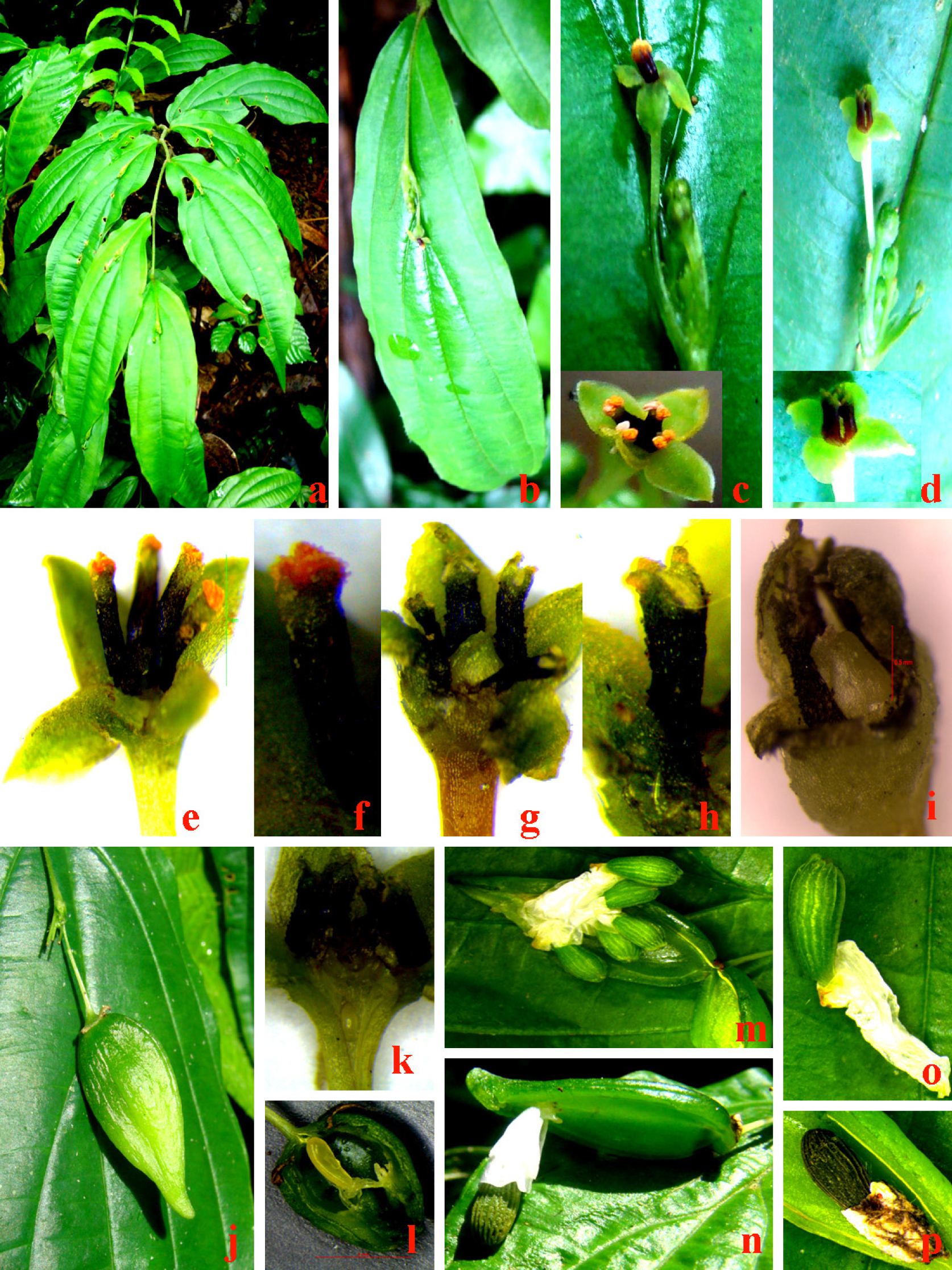Fruit and seed discoveries in Stichoneuron membranaceum Hook. f. (Stemonaceae): an endemic to Indo-Myanmar
Abstract
Stichoneuron membranaceum Hook. f. is an endemic species of Indo-Myanmar hotspot whose fruit and seed remained unknown to science since 1850, until they were collected from Tripura, Northeast India. Based on these gatherings, this study is the first report about the development and morphological features of fruit and seed. Earlier historical collections of this species were discussed. Its preferred habitat, possible pollinating agents and seed dispersal mechanism were also investigated.
References
Bawa K.S., Opler P.A. 1975. Dioecism in tropical forest trees. Evolution 29:167-179.
Cavigelli M., Poulos M., Lacey E.P., Mellon G. 1986. Sexual dimorphism in a temperate dioecious tree, Ilex montana (Aquifoliaceae). Am. Midl. Nat. 115 (2): 397-406.
Charnov E.L., Maynard S.J., Bull J.J. 1976. Why be an hermaphrodite? Nature 263: 125–126.
Deb D.B. 1983. The Flora of Tripura State, Vol. 2, Today and Tomorrows’ Printers and Publishers, New Delhi.
Duyfjes B.E.E. 1991. Stemonaceae and Pentastemonaceae; with miscellaneous notes on members of both families. Blumea 36 (1): 239–252.
Duyfjes B.E.E. 1992. Formal description of the family Pentastemonaceae with some additional notes on Pentastemonaceae and Stemonaceae. Blumea 36 (2): 551–552.
Duyfjes B.E.E. 1993. Stemonaceae. Flora Malesiana Ser. 1 11(2): 399–409.
Fetscher A.E. 2001. Resolution of male-female conflict in an hermaphroditic flower. Proceedings of the Royal Society, Ser. B., Biol. Sci. 268: 525–529.
Givnish T.J. 1980. Ecological constraints on the evolution of breeding systems in seed plants: dioecy and dispersal in gymnosperms. Evolution 34: 959–972.
Heywood V.H. 1978. Flowering plants of the world. Oxford University Press, London.
Hooker J.D. 1892. The flora of British India. Vol. 6: 297–299. L. Reeve & Co., London.
Inthachub P. 2008. Taxonomic revision on the family Stemonaceae in Thailand. M.Sc. Thesis. Graduate School, Kasetsart University, Thailand.
Inthachub P., Vajrodaya S., Duyfjes B.E.E. 2009. Review of the genus Stichoneuron (Stemonaceae). Edin. J. Bot. 66(2): 213–228.
Karthikeyan S., Jain S.K., Nayar M.P., Sanjappa M. 1989. Florae Indicae Enumeratio: Monocotyledonae. Flora of India. Ser. 4. Botanical Survey of India, Calcutta.
Kubitzki K.1998. Stemonaceae. In: Kubitzki K. (ed.), The families and genera of vascular plants. Vol. 3: 422–425. Springer, Berlin, Heidelberg.
Lloyd D.G. 1975. The maintenance of gynodioecy and androdioecy in angiosperms. Genetica 45: 325–329.
Mabberley D.J. 2008. Mabberley’s plant-book. A portable dictionary of plants, their classification and uses. Third Edition. Cambridge University Press, Cambridge.
Majumdar K., Datta B.K., Shankar U. 2011. Ten new additions of tree species to the Flora of Tripura state, North East India: Distributional range extension and geographic map. NeBIO 3 (1): 17–24.
Manicacci D., Després L. 2001. Male and hermaphrodite flowers in the alpine lily Lloydia serotina. Can. J. Bot. 79: 1107–1114.
Mayer S.S., Charlesworth D. 1991. Cryptic dioecy in flowering plants. Trends in Ecol. Eval. 6: 320–325.
Meagher T.R. 1980. The population biology of Chamaelirium luteum, a dioecious lily. I. Spatial distributions of males and females. Evolution 34: 1127–1137.
Pannell J. 1997. Variation in sex ratios and sex allocation in androdioecious Mercurialis annua. J. Ecol. 85: 57–69.
Pilli R.A., Ferreira de Oliveira M.C. 2000. Recent progress in the chemistry of the Stemona alkaloid. Nat. Prod. Rep. 17: 117–127.
Rudall J. P., Cunniff J., Wilkin P., Caddick R.L. 2005. Evolution of dimery, pentamery and the monocarpellary condition in the monocot family Stemonaceae (Pandanales). Taxon 54 (3): 701–711.
Tanaka N., Tanaka N., Ohi-Toma T., Murata J. 2007. New or noteworthy plant collections from Myanmar (2). Aponogeton lakhonensis, Cryptocoryne cruddasiana, C. crispatula var. balansae and Stichoneuron membranaceum. J. Jpn. Bot. 82: 266–273.
Valkenburg J.L.C.H., Bunyapraphatsara N. 2002. Plant resources of South-East Asia. 12 (2). Prosea Foundation, Indonesia.
Ye Y., Qin G.W., Xu R.S. 1994. Alkaloids from Stemona tuberosa. Phytochemistry 37: 1201–1203.


This work is licensed under a Creative Commons Attribution-NonCommercial-NoDerivatives 4.0 International License.
The journal is licensed by Creative Commons under BY-NC-ND license. You are welcome and free to share (copy and redistribute the material in any medium or format) all the published materials. You may not use the material for commercial purposes. You must give appropriate credit to all published materials.
The journal allow the author(s) to hold the copyrights and to retain publishing rights without any restrictions. This is also indicated at the bottom of each article.





